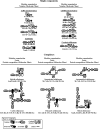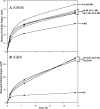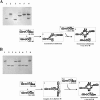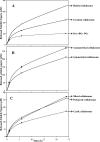Exploration of new geometries in cellulosome-like chimeras
- PMID: 17905885
- PMCID: PMC2168198
- DOI: 10.1128/AEM.01306-07
Exploration of new geometries in cellulosome-like chimeras
Abstract
In this study, novel cellulosome chimeras exhibiting atypical geometries and binding modes, wherein the targeting and proximity functions were directly incorporated as integral parts of the enzyme components, were designed. Two pivotal cellulosomal enzymes (family 48 and 9 cellulases) were thus appended with an efficient cellulose-binding module (CBM) and an optional cohesin and/or dockerin. Compared to the parental enzymes, the chimeric cellulases exhibited improved activity on crystalline cellulose as opposed to their reduced activity on amorphous cellulose. Nevertheless, the various complexes assembled using these engineered enzymes were somewhat less active on crystalline cellulose than the conventional designer cellulosomes containing the parental enzymes. The diminished activity appeared to reflect the number of protein-protein interactions within a given complex, which presumably impeded the mobility of their catalytic modules. The presence of numerous CBMs in a given complex, however, also reduced their performance. Furthermore, a "covalent cellulosome" that combines in a single polypeptide chain a CBM, together with family 48 and family 9 catalytic modules, also exhibited reduced activity. This study also revealed that the cohesin-dockerin interaction may be reversible under specific conditions. Taken together, the data demonstrate that cellulosome components can be used to generate higher-order functional composites and suggest that enzyme mobility is a critical parameter for cellulosome efficiency.
Figures









References
-
- Bayer, E. A., J. P. Belaich, Y. Shoham, and R. Lamed. 2004. The cellulosomes: multienzyme machines for degradation of plant cell wall polysaccharides. Annu. Rev. Microbiol. 58:521-554. - PubMed
-
- Blouzard, J. C., C. Bourgeois, P. de Philip, O. Valette, A. Bélaïch, C. Tardif, J. P. Bélaïch, and S. Pagès. 2007. Enzyme diversity of the cellulolytic system produced by Clostridium cellulolyticum explored by two-dimensional analysis: identification of seven genes encoding new dockerin-containing proteins. J. Bacteriol. 189:2300-2309. - PMC - PubMed
-
- Reference deleted.
-
- Bronnenmeier, K., K. Kundt, K. Riedel, W. H. Schwarz, and W. L. Staudenbauer. 1997. Structure of the Clostridium stercorarium gene celY encoding the exo-1,4-β-glucanase Avicelase II. Microbiology 143:891-898. - PubMed
Publication types
MeSH terms
Substances
LinkOut - more resources
Full Text Sources
Other Literature Sources

